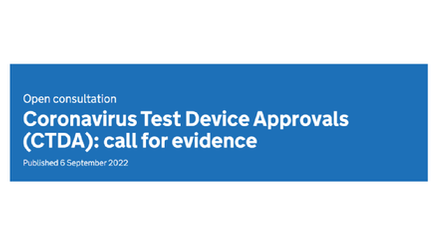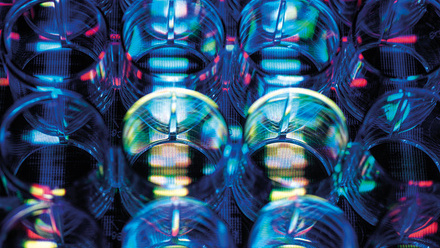Sars-CoV-2 Rapid Testing Options
This information aims to support scientists and other laboratory professionals in selecting and advising on the most appropriate rapid testing route for patients.
Primerdesign Q16
Test type
The exsig® COVID-19 Direct assay is a CE marked, in vitro diagnostic test intended for the qualitative detection of nucleic acid from SARS-CoV-2 from nasopharyngeal, oropharyngeal and nasal specimens prepared on dry swabs. The assay provides rapid screening of individuals suspected of SARS-CoV-2 infection and aids the diagnosis of suspected COVID-19 in patients.
The assay is a combination of a ‘direct to PCR’ sample processing method and a molecular in vitro diagnostic test for the detection of the SARS-CoV-2. The viral RNA is released from the swab sample via the addition of a viral inactivation/lysis agent. Following the sample preparation process, the resulting lysate is tested using well-established nucleic acid amplification technology. The PCR assay contains oligonucleotide primers and dual-labelled hydrolysis probes, as well as control material, for use in Real-Time RT-PCR for the in vitro qualitative detection of SARS-CoV-2 RNA.
Sample type
Nasopharyngeal swab: Swab specimens should be collected using swabs with a synthetic tip, such as nylon or dacron and with an aluminium or plastic shaft. Calcium alginate swabs are unacceptable and cotton swabs with wooden shafts are not recommended.
During sample processing, specimens should be tested immediately. If this is not possible, samples may be stored, after the dilution in exsig® Sample Preparation Buffer, for a maximum of 7 days at – 70°C.
Manufacturer's claims
Clinical Sensitivity 100%
Clinical Specificity 99.7%
PPV 98.7%
NPV 100%
Symptomatic/Asymptomatic
Both
Prevalence
To be deployed routinely regardless of prevalence.
Operation
- This assay must be carried out in an established molecular laboratory.
- Prior knowledge and training in unidirectional workflow is essential to prevent cross contamination.
- There is a high level of reagent manipulation prior to testing.
- 14 samples per cycle can be tested with a run time of 80 mins (however there is significant sample preparation time prior to testing).
- Analyser determines pos/neg results but ct values and curves are available for analysis.
- Analysers are not interfaced and therefore require manual transcription to LIMS.
- Separate workflow required to manage dry swabs.
- No multiplex option available.
- Reagents on national allocation limited to 168 tests/day.
Q32 Primerdesign
Test type
The Q32 Primerdesign utilises the same assay as the Q16.
Multiplex version also available:
The genesig® Real Time PCR SARS-COV-2 Winterplex is a CE marked, in vitro diagnostic, real-time, reverse transcriptase PCR (RT-PCR) multiplex assay intended for the qualitative detection of nucleic acid from SARS-CoV-2 (ORF1ab and S gene targets), Influenza A (Flu A), Influenza B (Flu B) and Respiratory Syncytial Virus (RSV A and B) in nasopharyngeal swabs, oropharyngeal swabs and sputum specimens.
Intended for use by qualified and trained clinical laboratory personnel specifically instructed and trained in the techniques of real-time PCR and in vitro diagnostic procedures. Specimen test results are available to interpret in under three hours. This time includes the time to extract nucleic acid from a specimen (on a separate analyser), PCR set-up, PCR run time, and to availability of results.
Sample type
Nasopharyngeal swab
Manufacturer’s Claims
Clinical Sensitivity 100%
Clinical Specificity 99.7%
For the singleplex (COVID only assay):
The evaluation sample-panel totalled 195 specimens, including upper or lower respiratory clinical specimens negative for SARS-CoV-2, as determined by the validated in-house Public Health England (PHE) PCR assay. Statistical assessment of the panel size determined that when the measured specificity for this sample size is 100% that the true specificity of the genesig® Real Time PCR COVID19 (CE IVD) assay was at least 98.2%. Samples contrived with SARS-CoV-2 RNA were all detected as positive, even when challenged following a three-step dilution series.
Data demonstrates that the genesig® Real Time PCR COVID-19 (CE IVD) assay detects 0.33 copies/μl of SARS-CoV-2 whole viral genome RNA ≥95% of the time. This concentration, therefore, is the limit of detection of the assay.
Symptomatic/Asymptomatic
Both
Prevalence
To be deployed routinely regardless of prevalence.
Operation
- The Q32 needs a separate extraction platform.
- This assay must be carried out in an established molecular laboratory.
- Prior knowledge and training in unidirectional workflow is essential to prevent cross contamination.
- There is a high level of reagent manipulation prior to testing.
- 30 samples per cycle can be tested with a run time under three hours using the genesig® Real Time PCR SARS-COV-2 Winterplex assay. This time includes the time to extract nucleic acid from a specimen (on a separate analyser), PCR set-up, PCR run time, and to availability of results.
- Analyser determines pos/neg results but ct values and curves are available for analysis.
- Analysers are not interfaced and therefore require manual transcription to LIMS.
- Reagents on national allocation limited to 360 tests/day.
Loop Mediated Isothermal Amplification (LAMP)
Test type
The Optigene LAMP is a nucleic acid amplification test (NAAT) method. It works using 4 or 6 sets of primers across a specified target region to enhance amplification in the virus genome and does not require temperature changes within the assay protocol as PCR does. In this case the target is the SARS-CoV-2 ORF1ab gene (a standard target for SARS-CoV-2 NAATs), it uses a reverse transcriptase to make cDNA copy of the virus genome as a first step before the amplification process. The amplification product is detection by fluorescence.
Sample type
Nasopharyngeal swab or extracted RNA. The Optigene has been evaluated for two protocols one involving RNA extraction of the sample before it is put into the LAMP analyser and one which takes samples directly from nasal or oral swabs. Clinical Evaluation of this testing assay was carried out by Fowler et al., 2020.
Manufacturer’s Claims
Extraction plus RT- LAMP Clinical Sensitivity 100%
Clinical Specificity 99.7%
Direct RT-LAMP directly from specimen (no extraction) Clinical Sensitivity 67%
Clinical Specificity 97%
In samples from clinical evaluation studies compared to standard RT-PCR, carried out by Fowler et al., 2020.
The kit manufacturer's information explicitly states that the direct method is not intended to detect strong positives - i.e. samples with high viral load. This means that it will be most effective in diagnosis of patients who are several days into the course of their infection and who display no symptoms or very mild symptoms and therefore are not aware that they have COVID-19 infection. It will be less effective in detecting patients at the beginning of the infection - in the 12-24-hour period where they are infectious but before they develop symptoms. In practice, it has been reported to be performing less well (46.7%).
Symptomatic/Asymptomatic
Mildly symptomatic or Asymptomatic
Prevalence
Clinical evaluation of the assay in Fowler et al. was carried during March, April and May 2020 - a period of high prevalence (approximately 40% positivity). Further evaluation is required during periods of low prevalence to determine prevalence dependence.
Operation
RT-LAMP reactions were performed using OptiGene Ltd. (Horsham, UK) COVID-19_RT-LAMP kits which target the ORF1ab region of the SARS-CoV-2 genome – for full methodology see Fowler et al., methods.
This online video also explains the principles of the LAMP assay – for SARS-CoV-2 there would be the extra step of making a copy of the viral RNA into cDNA as part of making the 'loop'.
LamPORE (Oxford Nanopore)
Test Type
LamPORE is a novel diagnostic platform for the detection of SARS-CoV-2 RNA that combines LAMP with nanopore sequencing, which could potentially be used to analyse thousands of samples per day on a single instrument. Following LAMP, COVID-19 genetic material has amplified and is then detected using a sequencer. If COVID-19 is detected the sequencer returns this result to the user.
LamPORE has an isothermal test developed from Oxford’s Nanopore DNA/RNA sequencing technology and consists of two key stages:
- Reverse Transcription Loop Mediated Isothermal Amplification (RT LAMP) to amplify the original SAR-CoV-2 genome. The targets are the N, E and ORF1a genes.
- Nanopore sequencing of the viral RNA fragments for precise analysis.
More information about LamPORE can be found in James et al.
Sample Type
Nasopharyngeal swab or saliva
Manufacturer’s claims
Clinical Sensitivity 99.1%
Clinical Specificity 99.6%
In samples from the University of Oxford’s clinical evaluation preprint study, Peto et al. Here, LamPORE was compared against standard RT-PCR. See study for more information.
Symptomatic/Asymptomatic
Symptomatic: False negatives in Peto et al. came mostly from patients with low levels of the virus who experienced mild symptoms or were asymptomatic.
Prevalence
LamPORE will be of maximal benefit if deployed during periods of high prevalence due to its highthroughput capability, it is designed to be used for rapid mass screening of workforces, communities and populations. Although, as it can test for several pathogens simultaneously, it could be used to screen for SARS-CoV-2 when prevalence is low.
Operation
LamPORE can be deployed in two versions:
- GridION–high throughput desktop sequencer capable of processing up to 10,000 samples in a 12 hour shift.
- MinION2–portable pocket sized sequencer suitable for rapid-response analyses capable of processing up to 1,000 samples per 12 hour shift.
- LamPORE is a precise, rapid and highly scalable assay, can be done manually or automated and requires relatively simple pipetting steps. It can be performed on both swabs and saliva – CE-marking is for swabs, but saliva has been validated and CE-marking will be updated accordingly.
- It performs with high sensitivity and specificity –equivalent to or greater than RT-qPCR
SAMBA II
Test type
The SAMBA II SARS-CoV-2 Test is a nucleic-acid based amplification test for the qualitative detection of nucleic acid from SARS-CoV-2 in human respiratory specimens.
Sample type
Nasopharyngeal swab. The assay requires combined nose and throat swabs (nasopharyngeal/oropharyngeal swabs). Flocked, rayon or dacron swabs are preferred for collecting respiratory samples.
Manufacturer’s claims
Clinical Sensitivity 98.7%
Clinical Specificity 100%
In 102 clinical samples compared to PHE testing.
Symptomatic/Asymptomatic
Manufacturer does not make a distinction; therefore, the system is CE IVD marked for both patient cohorts.
Prevalence
To be deployed routinely regardless of prevalence. Additional result checking may be required in times of low prevalence
Operation
- The test amplifies and detects the ORF1ab and nucleoprotein regions of the viral genome. They are reported as two distinct lines on the test strip. A third line, acts as a control for false negatives.
- This assay should be undertaken in a diagnostic laboratory environment.
- Prior knowledge and training in unidirectional workflow is essential to prevent cross contamination.
- Assay specific VTM required.
- Limited reagent or sample manipulation required.
- Ability to process 1 sample at a time
- Requires a minimum bank of 2 platforms to operate the system (optimum is 4) with each tablet.
- Median time to result is 156 minutes
- Qualitative result
- Analyser determines result but requires manual check as reports of misreading a positive when the QC line has failed (rare)
- Platform can be interfaced to LIMS
- Reagents on national allocation
- Multiplex assay currently not available
- Laboratory requires regular environmental monitoring to prevent/identify contamination.
Innova Rapid Antigen – Lateral Flow Technology (LFT)
Test type
The SARS-CoV-2 Antigen Rapid Qualitative Test is a colloidal gold immunochromatography intended for the qualitative detection of nucleocapsid antigens from SARS-CoV-2 in human nasal swabs or throat swabs from individuals who are suspected of COVID-19 by their healthcare provider within the first five days of the onset of symptoms. Results are for the identification of SARS-CoV-2 nucleocapsid antigen. Time taken to produce result is given as 20-30 minutes.
The antigen test is intended for use by trained clinical laboratory personnel specifically instructed and trained in the techniques of in vitro diagnostic procedures, and proper infection control procedures and individuals similarly trained in point of care settings.
Sample type
Nasopharyngeal swab
Manufacturer’s Claims
Clinical Sensitivity 96%
Clinical Specificity 100%
In samples from clinical evaluation studies compared to standard RT-PCR. However, sample size was only 75 positive samples, so further evaluation of the test is required (see table of results under clinical performance for more details, see manufacturer’s guide.
Symptomatic/Asymptomatic
The manufacturer states the performance of this test has not been evaluated for use in patients without signs and symptoms of respiratory infection and performance may differ in asymptomatic individuals.
Prevalence
Dependent on prevalence rates. The manufacturer states positive and negative predictive values are highly dependent on prevalence rates. Positive test results are more likely to represent false positive results during periods of little/no SARS-CoV-2 activity when disease prevalence is low. False negative test results are more likely when prevalence of disease caused by SARS-CoV-2 is high.”
Operation
This reagent is based on colloidal gold immunochromatographic assay. During the test, specimen extracts are applied to the test cartridges. If there were SARSCoV-2 antigen in the extract, the antigen will bind to the SARS-CoV-2 monoclonal antibody. During lateral flow, the complex will move along the nitrocellulose membrane toward the end of the absorbent paper. When passing the test line (line T, coated with another SARS-CoV-2 monoclonal antibody) the complex is captured by SARSCoV-2 antibody on test line resulting in colouring on line T; when passing the line C, colloidal goldlabeled goat anti-rabbit IgG is captured by control line (line C, coated with rabbit IgG) resulting in colouring on line C. Results are read after 20-30 minutes.
Interpretation of Results:
Negative result: There is colour on line C only indicating that the assay has operated correctly but, but that no SARS-CoV-2 antigen was detected in the specimen.
Positive result: Colour is visible on both line C and line T showing the assay worked as expected and SARS-CoV-2 antigen was detected in the specimen.
Invalid result: If there is no visible C line, this indicates that the test is invalid due to an issue with the cartridge or operator error and the assay should be repeated with a new cartridge.
DnaNudge (CovidNudge)
Test Type
DnaNudge is an RT-PCR Assay “lab on a chip” cartridge design for Point of Care use. System designed as a portable reader and a disposable Cartridge with a sample to result time of approx. 90 minutes. Downside can only test a single sample at a time. Use of several devices per clinical area and appropriate prioritisation of samples is therefore advised. Time from sample to result 90 minutes.
Sample type
Nasopharyngeal swab or Sputum
Manufacturer’s Claims
Clinical Sensitivity 94-97%
Clinical Specificity 100%
A recent evaluation study comparing DnaNudge to a standard RT-PCR in 386 paired samples found 94% sensitivity, for further information, see Gibani et al.
Initial evaluation Imperial NHS Trust London, (Various sites) Oxford University Hospitals NHS Trust (John Radcliffe Hospital) , also see recent evaluation study Gibani et al., comparing DnaNudge to a standard RT-PCR in 386 paired samples which found 94% sensitivity.
Symptomatic/Asymptomatic
Both.The Initial evaluation included:
- Self-referred symptomatic Health care workers
- Asymptomatic Hospital In-Patient admissions
Prevalence
Dependent on prevalence rates. The positive and negative predictive values are highly dependent on prevalence rates. Positive test results are more likely to represent false positive results during periods of little/no SARS-CoV-2 activity when disease prevalence is low. False negative test results are more likely when prevalence of disease caused by SARS-CoV-2 is high.
Operation
The platform comprises two components: the DNACartridge and a processing unit (NudgeBox) (fi). The DNACartridge (25 × 78 × 85 mm; 40 g) is a disposable, sealed, and integrated lab-on-chip device that enables sample-to-result PCR.
The DNACartridge consists of two main parts: an amplification unit and a sample preparation unit. A nasopharyngeal or oropharyngeal swab is immediately inserted directly into the swab chamber of the sample preparation unit at the time of collection. The swab is broken, leaving the swab tip and the sample within the chamber, which is then sealed. Cartridges are placed in the Nudgebox processing unit (28 × 15·5 × 13·5 cm; 5 kg), which provides the pneumatic, thermal, imaging, and mechanics required to run a real-time RT-PCR reaction outside a laboratory setting.
The sample preparation unit consists of a rotating mixing unit and circumferentially distanced chambers containing buffers to extract and purify RNA from the swab sample, as well as a lyophilised PCR master-mix to mix with the extracted RNA. The sample preparation unit mixing chamber fits on top of a motor-driven spigot in the NudgeBox, which rotates the mixing unit through each stage of sample processing before filling the wells of the amplification unit, inside which the PCR reaction takes place.
Exposed surfaces of the instruments are cleaned regularly between operators with 10% bleach, followed by an isopropyl alcohol wipe to remove any residual bleach. Following the test, the singleuse cartridge is disposed of following standard laboratory disposal procedures.
Each Cartridge tests for 7 targets of SARS-CoV-2 genome:
CDC-N1 10 Replicates
CDC-N2 10 Replicates
CDC-N3 10 Replicates
Charite Berlin-E 10 Replicates
Institute Pasteur –RdRP-IP2 9 Replicates
Institute Pasteur –RdRP-IP4 9 Replicates
RNAseP Control 6 Replicates





